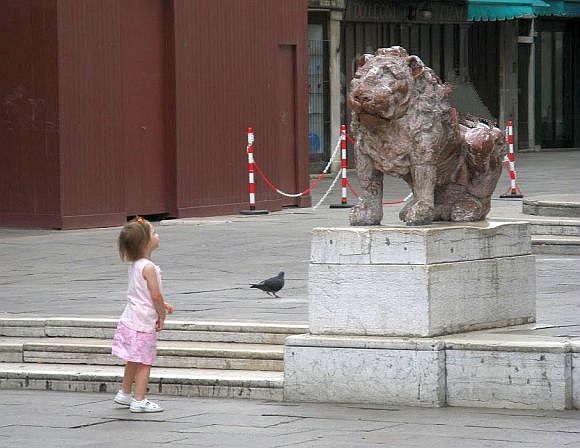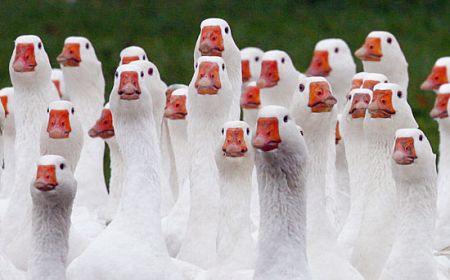Ever since tourists have taken over Venice, nobody thinks much about other life forms (except maybe fish), but there have been many more creatures here than dogs and cats and the occasional canary.

Last night we were sitting on a full vaporetto trundling its way from the train station toward the Lido. We were facing forward, but some people a few rows ahead were facing backward. I had seen them, but until Lino spoke up, I had not observed (as Sherlock Holmes would put it).
Lino: “Did you see ‘Little Snail’?” (I refrain from translating his nickname in Venetian; this is a small town, as I may have mentioned).
Me: “No.” (Short answer meaning “Mainly because I have no idea who he is.”)
Lino indicates a now completely obvious person, a man whose chronological engine seems to have stalled just after middle age, kind of like Piers Morgan. The man is wearing a whitish baseball cap with some inscription, and a red windbreaker. He’s alone, looking nowhere in particular.
“He used to live near me,” Lino went on. “For a while, he had a pet mallard. He’d put a leash on it and he’d walk around the neighborhood with it.”
If you might think this is eccentric, there used to be a man who lived near Santa Marta who kept monkeys. His name was Ricco — “Richetto,” as a diminutive. His house was full of smallish monkeys, macaques, whatever they were.
Sometimes he’d go out for a stroll with one of them on his shoulder.

“The neighbors couldn’t wait till he died.”
You can understand it — living next to the Primates Enclosure in Venice wouldn’t be a very great thing, but certainly that was back in the Dark Ages, before consumers and the environment and the health department had been invented.
“No no,” Lino said, “this went on up till the Sixties, even the Seventies.” But hey — Lino’s godmother Eugenia, who lived in the same courtyard where his family lived, kept a couple of geese in the storage room. He doesn’t know why they were there, but he does remember her force-feeding them. This was two steps from Campo San Barnaba, not down in the Po Delta.

But that’s nothing! His cousin Carla (“who lived in the calle de l’Avogaria, you know, where the fountain is that doesn’t run anymore”) lived on the ground floor, and she had a pet rat. Not that she kept it, it just came to visit. “There was a hole in the wall of the bedroom, and sometimes the rat would come out, and she’d pick it up and caress it, call it nicknames…”
And speaking of rats, there was Lino’s friend who lived on the Fondamenta Bragadin, next door to the Spanish Ambassador. The friend kept some chickens in his little courtyard, but sometimes he (the friend, not Lino or the ambassador) would come out in the morning and discover one of the chickens had been killed and sort of half-disemboweled by the rats, who wanted to get at the liver. I used to like chicken livers too, until I heard this story about five minutes ago.
Back to the “Snail.” Something about the name brought back a prehistoric memory of something Lino once told me.
“Isn’t he the one who used to howl like a wolf?”
“Yep. He’d come home really drunk some nights, like at 2:00 AM, howling just like a wolf.” (Whisper: “Ah-WOOOOoooooooooooo….”)
If you might wonder what kind of work a person with that skill might do, he was a gondolier. Not a job that usually calls for howling, though I have to say it would have been cool if he’d taken his duck with him. You know, “Take your duck to work” Day.
Lino: “But he only worked for a couple of years, then sold his license and just lived on the money ever since. He had seven or eight brothers, he was the littlest.”
“In size, or in birth order?” (I need to understand what I’m being told.)
“Birth order. He’s the last one left. He’s got a nice house and everything.”
Any children?
“Nope. Never married.”
I guess I could see that. The wife would never know whether “Honey, I’m home” was going to be carnivorous keening or a couple of heartrending quacks.

3 Comments
A charming look into the lesser known byways. Thanks for cheering the morning.
Lovely post! And it took me back to your earlier post on dogs which I hadn’t read, only having discovered your blog recently. I have always loved looking for the dogs in paintings but apart from Carpaccio, and the adorable dog in St Augustine’s study (which is my all time favourite) I’m often surprised by how badly the masters painted them! It’s not as if they didn’t have plenty of models ? Mind you, they were pretty rubbish at painting babies, too – even Bellini. Very odd!
Loved reading this piece! Love the sound of your Lido too!!! 🙂 How interesting he makes life.